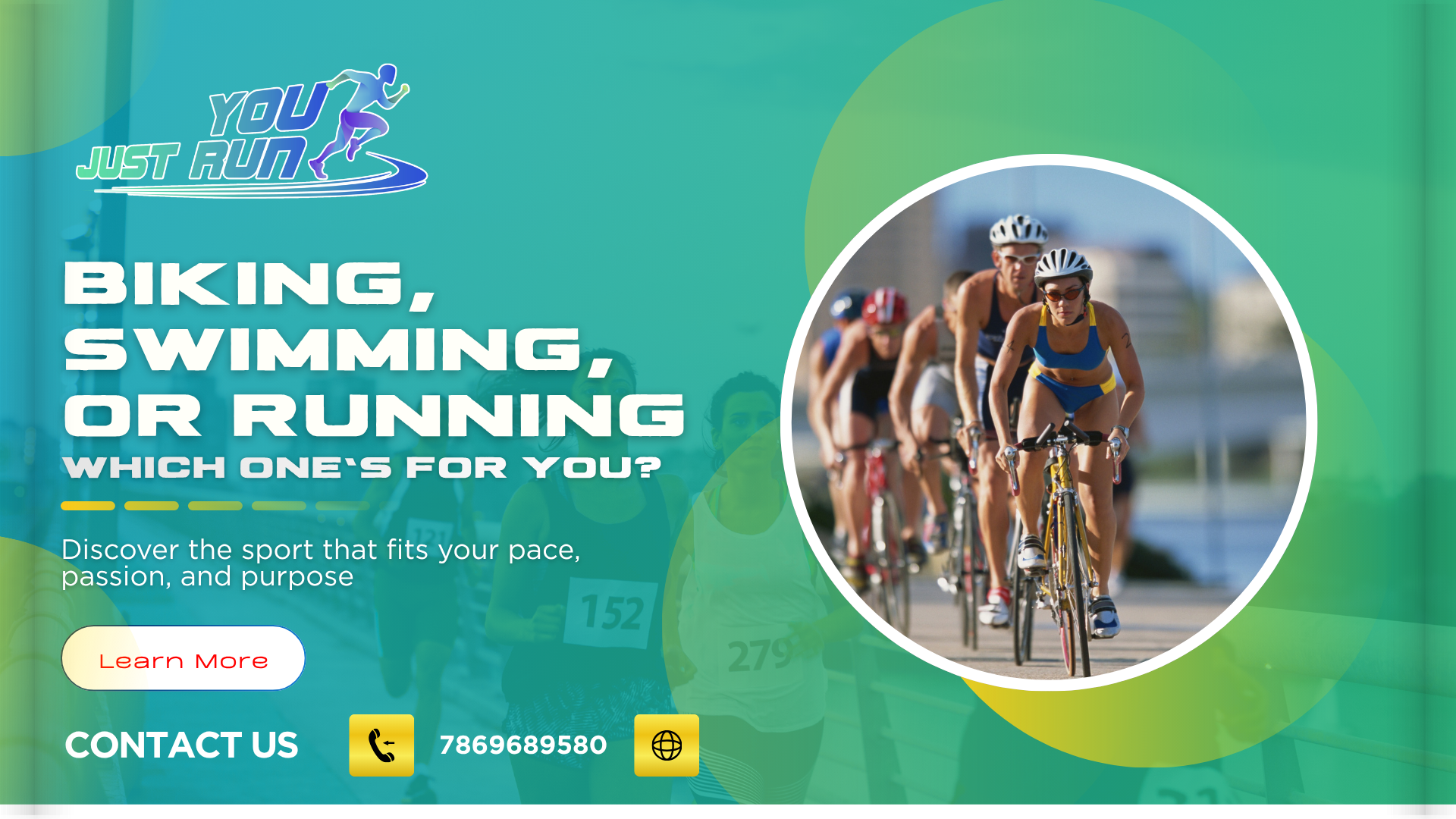When it comes to well-being, fitness, and endurance, biking, swimming and running are three of the best full-body exercises. All three sports carry rewards, drawbacks, and a level of popularity. Cycling reduces all-cause mortality by 21%, running by 23% and swimming by 24%. So, how do you know which one is perfect for you?
Whether your goal is to improve endurance, lose weight, train for an upcoming event, or simply remain active, this blog will guide you in choosing what’s right for your body, goals, and lifestyle.
Cycling – Low Impact, High Endurance
It’s suitable for improving cardiovascular fitness while minimizing impact on your joints.
Cycling may be the best workout that builds endurance and lower-body strength/power. Cycling uses your hamstrings, quadriceps, glutes, and calves. It is also a low-impact workout that minimizes stress on your ankles and knees.
Other health benefits of cycling routinely include improved heart health, posture, and coordination with age. A study indicated that individuals who cycled frequently had a 46% lower chance of developing heart disease than non-cyclists.
Fitness Benefits
Excellent for cardiovascular health and endurance
Strengthens lower body muscles with minimal joint impact
Improves balance and coordination
Can be performed outdoors and indoors (stationary bike)
Works well for long-distance endurance training
Considerations
Requires a bike and equipment: helmet, gloves, shoes, etc.
Exercise can be impacted by the weather if cycling outside
Cycling may not be effective for upper-body strength unless paired with other workouts
It’s a great rhythmic workout to enjoy nature and great for those who need a long-term cardio routine that’s easy on joints.
Swimming – Total Body Exercise with Minimal Stress
Ideal for: Individuals who want all-over conditioning, muscle tone, and flexibility.
Swimming has the unique quality of exercising almost every muscle in your body, from your shoulders and arms to your core and legs, all while minimizing stress on your joints. The weight of the water supports your body, and your joints don’t experience the same level of stress as, for example, running or heavy weightlifting.
It’s also a mental pick-up. Water immersion and rhythmic breathing encourage relaxation and awareness, making it as beneficial to mental well-being as it is to physical fitness.
Fitness Benefits
It strengthens the entire body, particularly the core, shoulders, and back
Enhances lung capacity and control of breathing
Improves flexibility and posture
Lessens joint stress and risk of injury
Burns calories effectively and is low impact
Things to Consider
Need access to a pool or secure open-water environment
Technique matters; beginners might need to take lessons
Equipment such as goggles, caps, and swimwear is required
Perfect For- Individuals seeking a balanced workout incorporating cardio, strength, and flexibility, and those who appreciate a peaceful, meditative atmosphere.
Running – Easy, Accessible, and Incredibly Effective
Best suited for: People wanting to increase stamina, lose weight, and strengthen their heart.
Running is potentially the simplest exercise. All you need is a pair of shoes and a place to run. It strengthens your heart muscles and lung capacity and builds endurance. Running is also a healthy way to relieve stress. It creates the workout equivalent of endorphins (the “runner’s high”), which helps put you in a good mood.
Studies show that even short runs every day can significantly reduce your chances of dying of cardiovascular disease and may even help you live longer.
Fitness Benefits
Excellent for cardiovascular health and calorie burning
Increases lower-body strength and bone density
Helps improve mood and mental clarity
Helps with sleep regularity and stress reduction
Very little equipment
Things to Remember
It’s high impact on the joints, so could be uncomfortable for some people
Injury could happen without proper form and shoes
Weather could be a factor for outdoor runs
Perfect for- People that want to work out alone, enjoy high-intensity cardiovascular workouts, or feel satisfaction from metrics of performance (timing, pace, distance).
Comparative Overview
| Feature | Biking | Swimming | Running |
| Impact on joints | Low | Very Low | High |
| Calories Burned per hour | 400–600 | 500–700 | 600–800 |
| Muscle Groups Targeted | Lower body | Full body | Lower body & core |
| Accessibility | Requires bike & gear | Needs pool access | Easily accessible |
| Weather Dependence | Yes | No (Indoors) | Yes |
| Ideal for | Endurance, joint health | Full-body fitness, recovery | Weight loss, stamina |
Which One Should You Choose?
It really depends on your goals and what you prefer:
Choose to bike if you want an optimal way to gain endurance and a minimal impact on joints.
Choose to swim if you want a comprehensive, holistic, and low-impact full-body workout.
Choose to run if you want an intensity-based workout that is simple and provides visible results.
If you find variety more enjoyable, you do not have to choose just one – many endurance athletes use all three in their training program, especially those who are training for triathlons. The combination balances muscle development, prevents overuse injuries, and makes workouts stimulating.
In Conclusion
Each of the activities of Biking Swimming Running each adds a unique component to your fitness journey. The best sport for you is the one that you will participate in with the least resistance because it’s consistency (not intensity) that produces long-term results.
Whether it is biking through beautiful scenery, gliding through the pool, or sprinting across the finish line, every movement takes you one step closer to your strongest self.








